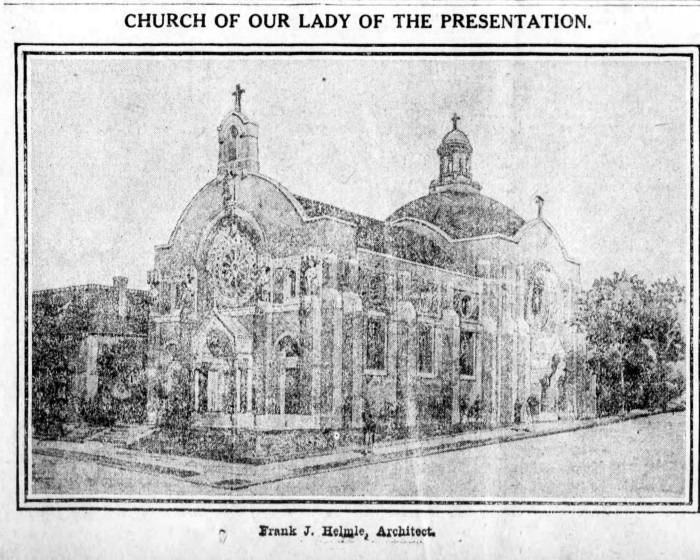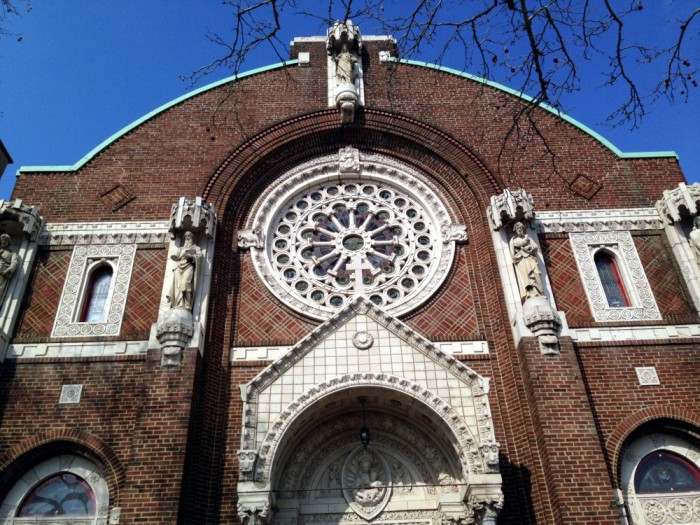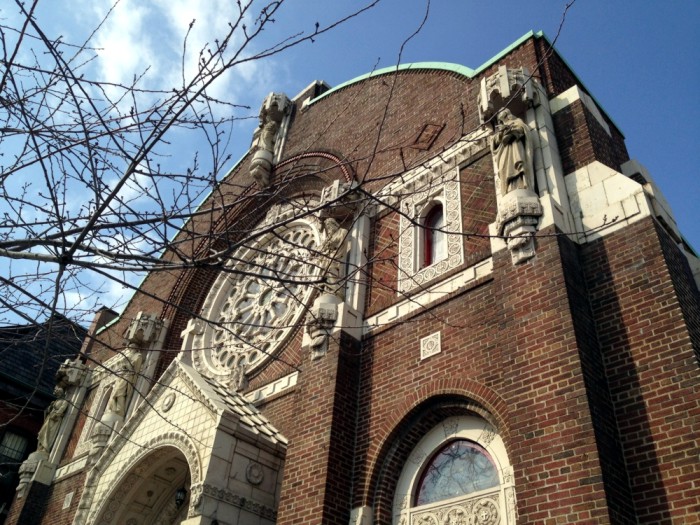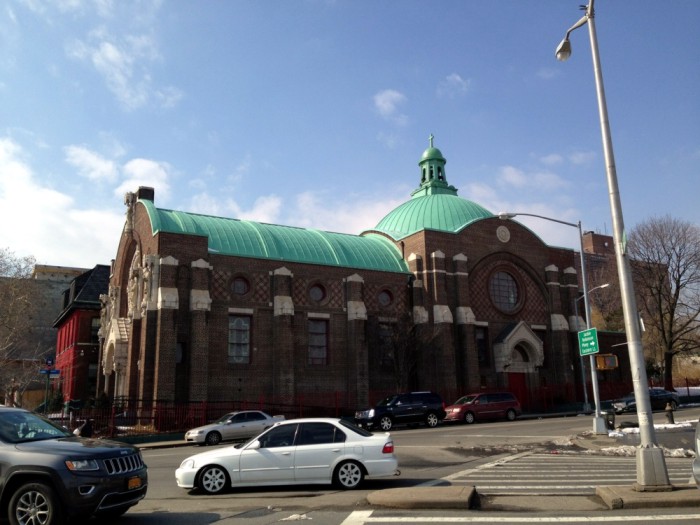Building of the Day: 1677 St. Marks Avenue
Brooklyn, one building at a time. Name: Our Lady of the Presentation-Loreto Roman Catholic Church Address: 1677 St. Marks Avenue Cross Streets: Corner Rockaway Boulevard Neighborhood: Ocean Hill Year Built: 1910-1911 Architectural Style: Byzantine Revival Architect: Frank J. Helmle Other Buildings by Architect: St. Barbara’s Catholic Church in Bushwick, St. Gregory the Great Catholic Church…

Brooklyn, one building at a time.
Name: Our Lady of the Presentation-Loreto Roman Catholic Church
Address: 1677 St. Marks Avenue
Cross Streets: Corner Rockaway Boulevard
Neighborhood: Ocean Hill
Year Built: 1910-1911
Architectural Style: Byzantine Revival
Architect: Frank J. Helmle
Other Buildings by Architect: St. Barbara’s Catholic Church in Bushwick, St. Gregory the Great Catholic Church in Crown Heights North, plus Bossert Hotel in Brooklyn Heights, Boat House in Prospect Park, Park shelters in Fulton and McGolrick parks, Greenpoint Savings Bank and Williamsburg Trust bank, and many, many more
Landmarked: No
The story: The more I find out about Frank Helmle’s work, the more I have to move him up in the pantheon of Brooklyn’s great architects. The man had incredible talent and versatility. He had an uncanny and valuable ability to take the architecture of other times, places and cultures and translate it into something modern for his time and place. He used this talent often and well, but it is perhaps most clearly shown in his church architecture.
This parish started out a long way from a corner lot at the joining of several important streets in Ocean Hill. Our Lady of the Presentation of the Blessed Virgin Mary was started in 1887 in the South Brooklyn home of the Reverend Hugh Hand. The first real mass was celebrated in Luhr’s Hall, on East New York Avenue and Osborne Street with 30 people in attendance. The congregation purchased this corner plot and had a wood-framed church built within the next year or so. That wooden church was soon too small, and it was enlarged in 1896. When the church was built, so too was the brick rectory building next door.
Rev. Hand remained the pastor here until his death in 1909. That year, Rev. James F. Flynn was made the pastor. He was in charge when the wooden church burned down in 1910. The church rallied, held mass in a large tent erected on site, and began raising money to build a new church. Rev. Flynn had a reputation for appreciating good architecture and knowing his architects, so he must have been quite happy to have Frank J. Helmle on board to design the new church. He may have even suggested him.
At that time, Helmle had already completed one of his best churches – St. Barbara’s Church in Bushwick. That building is a wonderfully ornate Spanish Baroque church that would have been quite at home in Europe. The church is beautiful inside and out, with the façade covered with carved ornament depicting cherubs and saints, foliage, fauna, architectural motifs, and whatever else he could have put on there. Frank could be a more is more kind of guy, and in his churches, he didn’t skimp.
Our Lady of the Presentation would be his church that came between St. Barbara’s of 1909 and St. Gregory the Great, which was begun in 1915. All three churches draw on the great Catholic Church styles of Europe; St. Barbara’s in Baroque Italy and Spain during the late 16th century, St. Gregory’s is a classic Roman basilica, and Our Lady of the Presentation’s designs are reminiscent of Byzantine architecture.
Helmle had studied architecture at Cooper Union, went on to further study at the Architecture School of the Brooklyn Institute of Arts and Science, and then worked for McKim, Mead & White for a few years before going out on his own. All three of those training programs had steeped him in the classics, and in how to reinterpret them for his day. And if you look closely at this church in relationship to his other work, it is classic Helmle.
The Brooklyn Eagle reporter covering the design of the new church was quite descriptive. The interior has a wide nave spanned by a single vault, with no columns or supports, giving congregants a clear view to the altar. A large dome is above the altar. A free-standing arch supported by marble columns separates the altar from the nave. A large gallery over the vestibule houses the choir loft and the organ. The church is lighted by large rectangular side windows, with smaller round windows above. Two rose windows are over the side entrances, and a large stained glass rose window is in the front wall of the church. Above the altar, three large stained glass windows illuminate that space.
Byzantine Revival was not a common style for Brooklyn. I’ve only read about one other Byzantine Revival church in the borough, and that one is nearby: the former First Church of Christ Scientist, now the Hebron 7th Day Adventist Church on the corner of New York Avenue and Dean Street, in Crown Heights North. That one was designed about the same time this one was, but the architect was Henry Ives Cobb. The two men used very different materials, and came up with two very different looking churches. Helmle’s church is much closer to true Byzantine style.
All in all, the author of the Eagle piece was quite taken by the building. He must have had some technical architectural or engineering knowledge, as he gushed profusely on the engineering of the dome, which was pretty impressive. Helmle’s unique design touch is also seen in the patterned brick on the façade. He uses a subtle decorative or herringbone pattern in all of his brickwork; it’s one of the signatures of his work.
You may recall about five years ago when a nearby church, Our Lady of Loreto, was going to be torn down for housing. It was discussed here on Brownstoner. After a successful fight against destruction, that historic church, which had been built by its parishioners in the early 20th century, was indeed saved, and housing was built as well. The dioceses merged this parish with the shuttered Our Lady of Loreto in 2010, then in 2011, also merged another parish, Our Lady of Mercy, into this one parish. Its official name is now Our Lady of the Presentation/Loreto. Hopefully, she will survive far into the future.
Thanks to our managing editor Cate, who told me about this church, and took most of the photographs.
(Photo: Cate C.)













What's Your Take? Leave a Comment